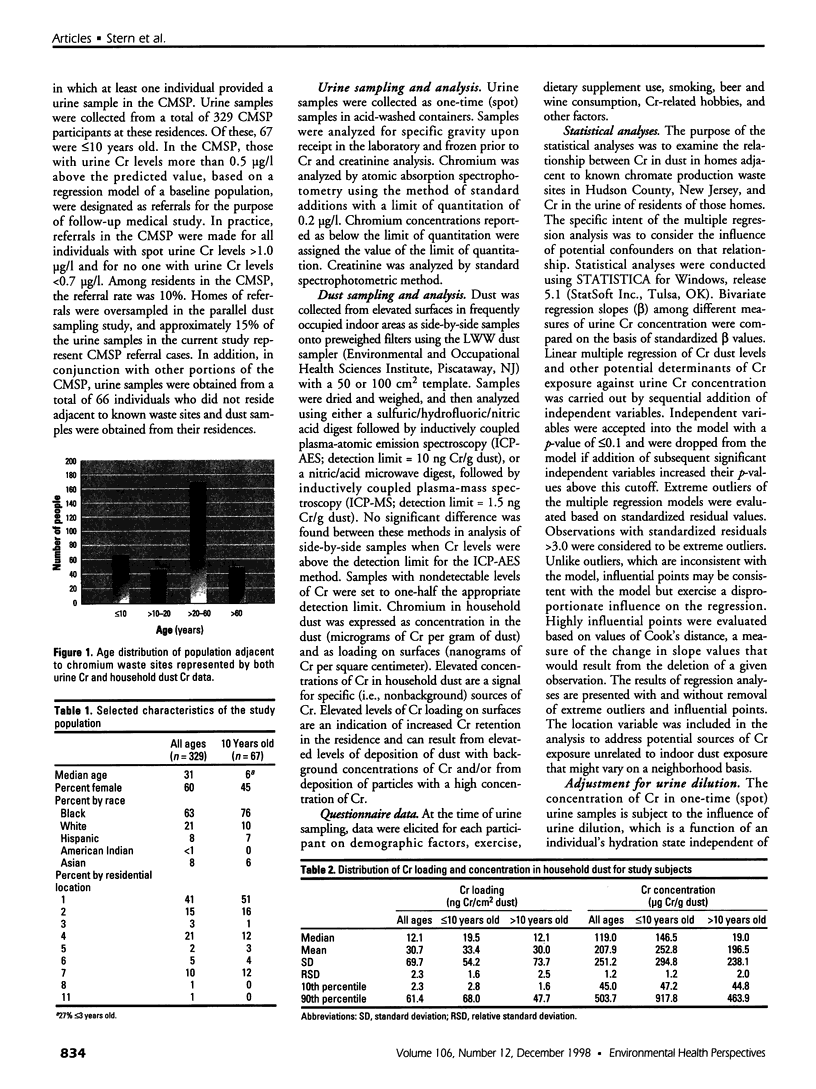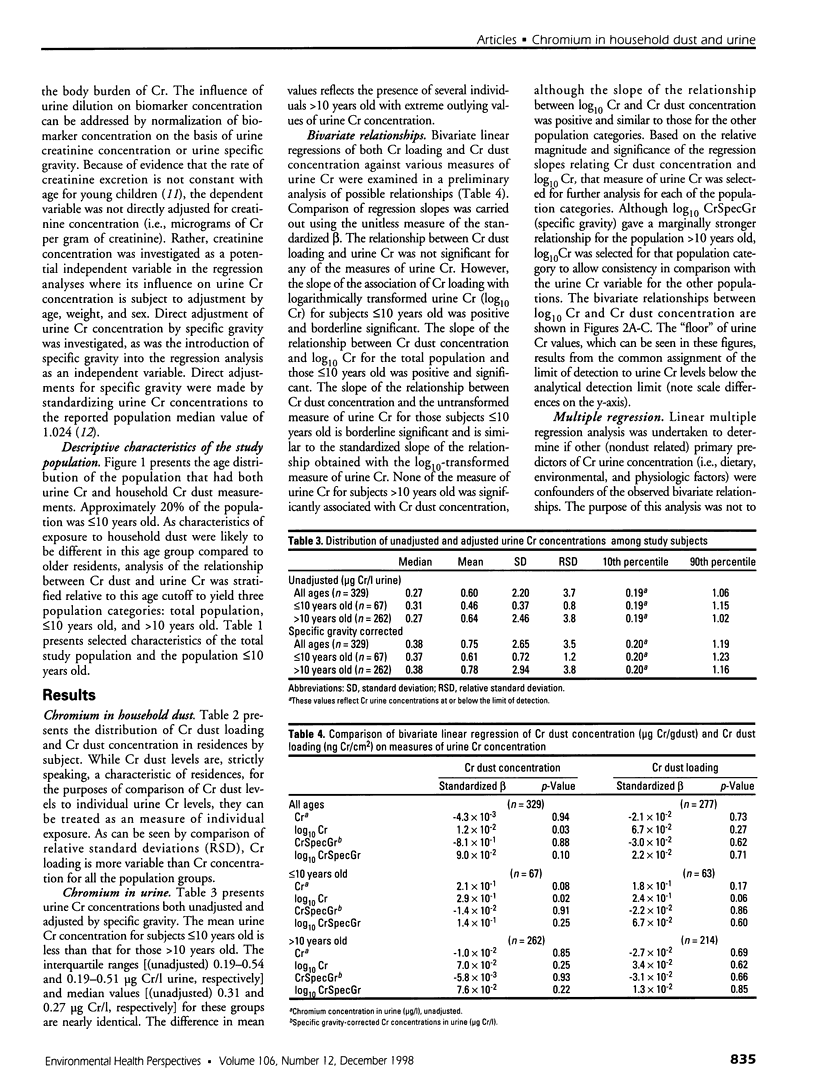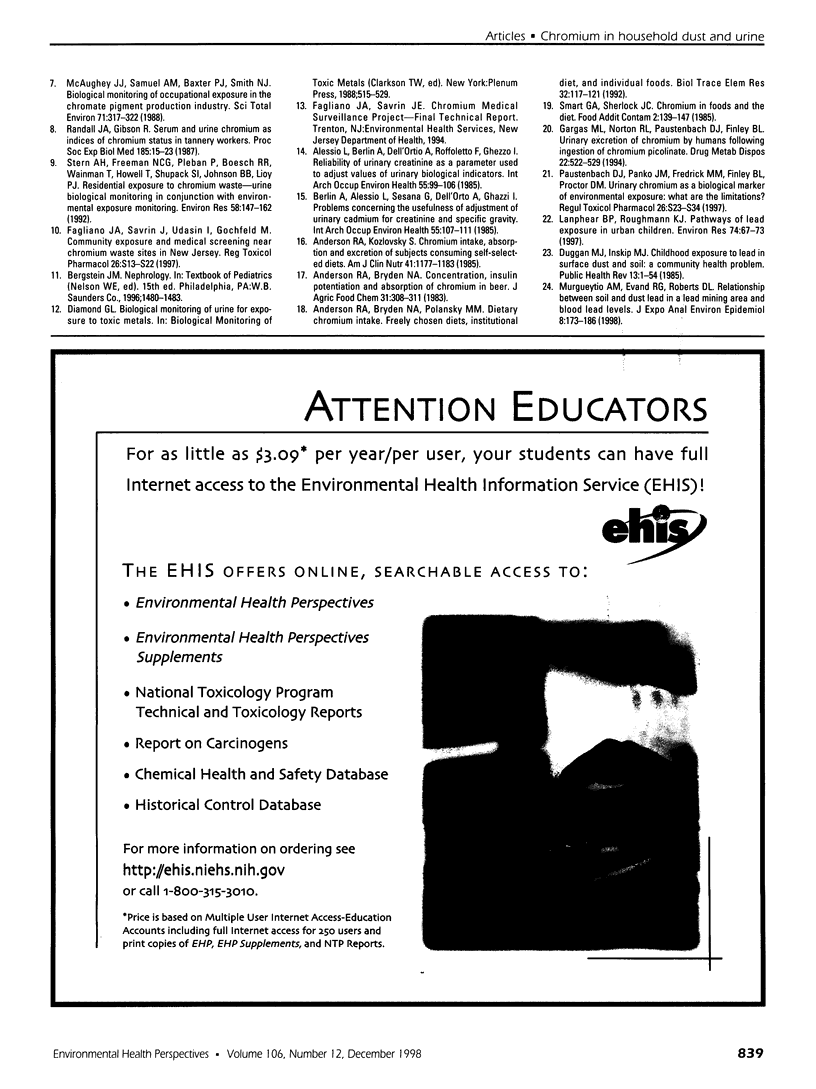Abstract
Several previous studies of exposure to chromium waste in New Jersey have shown that Cr levels are elevated in household dust in homes adjacent to waste sites and that Cr levels in the urine of residents near sites are also elevated compared to control populations. It has not been possible until now, however, to examine these external and internal measures of exposure together in a large population to determine whether the external exposure is predictive of the internal exposure. We investigated the relationship between various adjusted and unadjusted measures of spot urine Cr concentration and household dust Cr from residents and residences adjacent to known Cr waste sites. Statistically significant bivariate relationships were found between log-transformed urine Cr concentration and Cr dust concentration (micrograms of Cr per gram of dust) but not Cr dust loading (nanogram Cr per square centimeter). Log-transformed urine concentration was used as the dependent variable in multiple regression analysis of the total population (n = 329), the population [less than/equal to] 10 years old (n = 67), and the population >10 years old (n = 262), with Cr dust concentration as a mandatory independent variable. Other potential direct influences on urine Cr were investigated as potential confounders of this relationship. In the final models for the entire population and those [less than/equal to] 10 years old, but not for those >10 years old, Cr dust concentration remained significant. This suggests that exposure of young children to Cr in household dust accounts for much of the relationship in the entire population.
Full text
PDF






Images in this article
Selected References
These references are in PubMed. This may not be the complete list of references from this article.
- Alessio L., Berlin A., Dell'Orto A., Toffoletto F., Ghezzi I. Reliability of urinary creatinine as a parameter used to adjust values of urinary biological indicators. Int Arch Occup Environ Health. 1985;55(2):99–106. doi: 10.1007/BF00378371. [DOI] [PubMed] [Google Scholar]
- Anderson R. A., Bryden N. A. Concentration, insulin potentiation, and absorption of chromium in beer. J Agric Food Chem. 1983 Mar-Apr;31(2):308–311. doi: 10.1021/jf00116a031. [DOI] [PubMed] [Google Scholar]
- Anderson R. A., Bryden N. A., Polansky M. M. Dietary chromium intake. Freely chosen diets, institutional diet, and individual foods. Biol Trace Elem Res. 1992 Jan-Mar;32:117–121. doi: 10.1007/BF02784595. [DOI] [PubMed] [Google Scholar]
- Anderson R. A., Kozlovsky A. S. Chromium intake, absorption and excretion of subjects consuming self-selected diets. Am J Clin Nutr. 1985 Jun;41(6):1177–1183. doi: 10.1093/ajcn/41.6.1177. [DOI] [PubMed] [Google Scholar]
- Berlin A., Alessio L., Sesana G., Dell'Orto A., Ghezzi I. Problems concerning the usefulness of adjustment of urinary cadmium for creatinine and specific gravity. Int Arch Occup Environ Health. 1985;55(2):107–111. doi: 10.1007/BF00378372. [DOI] [PubMed] [Google Scholar]
- Duggan M. J., Inskip M. J. Childhood exposure to lead in surface dust and soil: a community health problem. Public Health Rev. 1985;13(1-2):1–54. [PubMed] [Google Scholar]
- Fagliano J. A., Savrin J., Udasin I., Gochfeld M. Community exposure and medical screening near chromium waste sites in New Jersey. Regul Toxicol Pharmacol. 1997 Aug;26(1 Pt 2):S13–S22. doi: 10.1006/rtph.1997.1134. [DOI] [PubMed] [Google Scholar]
- Freeman N. C., Stern A. H., Lioy P. J. Exposure to chromium dust from homes in a Chromium Surveillance Project. Arch Environ Health. 1997 May-Jun;52(3):213–219. doi: 10.1080/00039899709602889. [DOI] [PubMed] [Google Scholar]
- Gargas M. L., Norton R. L., Paustenbach D. J., Finley B. L. Urinary excretion of chromium by humans following ingestion of chromium picolinate. Implications for biomonitoring. Drug Metab Dispos. 1994 Jul-Aug;22(4):522–529. [PubMed] [Google Scholar]
- Lanphear B. P., Roghmann K. J. Pathways of lead exposure in urban children. Environ Res. 1997;74(1):67–73. doi: 10.1006/enrs.1997.3726. [DOI] [PubMed] [Google Scholar]
- Lioy P. J., Freeman N. C., Wainman T., Stern A. H., Boesch R., Howell T., Shupack S. I. Microenvironmental analysis of residential exposure to chromium-laden wastes in and around New Jersey homes. Risk Anal. 1992 Jun;12(2):287–299. doi: 10.1111/j.1539-6924.1992.tb00676.x. [DOI] [PubMed] [Google Scholar]
- McAughey J. J., Samuel A. M., Baxter P. J., Smith N. J. Biological monitoring of occupational exposure in the chromate pigment production industry. Sci Total Environ. 1988 Jun 1;71(3):317–322. doi: 10.1016/0048-9697(88)90203-3. [DOI] [PubMed] [Google Scholar]
- Minoia C., Cavalleri A. Chromium in urine, serum and red blood cells in the biological monitoring of workers exposed to different chromium valency states. Sci Total Environ. 1988 Jun 1;71(3):323–327. doi: 10.1016/0048-9697(88)90204-5. [DOI] [PubMed] [Google Scholar]
- Murgueytio A. M., Evans R. G., Roberts D. Relationship between soil and dust lead in a lead mining area and blood lead levels. J Expo Anal Environ Epidemiol. 1998 Apr-Jun;8(2):173–186. [PubMed] [Google Scholar]
- Paustenbach D. J., Panko J. M., Fredrick M. M., Finley B. L., Proctor D. M. Urinary chromium as a biological marker of environmental exposure: what are the limitations? Regul Toxicol Pharmacol. 1997 Aug;26(1 Pt 2):S23–S34. doi: 10.1006/rtph.1997.1135. [DOI] [PubMed] [Google Scholar]
- Randall J. A., Gibson R. S. Serum and urine chromium as indices of chromium status in tannery workers. Proc Soc Exp Biol Med. 1987 May;185(1):16–23. doi: 10.3181/00379727-185-42510. [DOI] [PubMed] [Google Scholar]
- Sjögren B., Hedström L., Ulfvarson U. Urine chromium as an estimator of air exposure to stainless steel welding fumes. Int Arch Occup Environ Health. 1983;51(4):347–354. doi: 10.1007/BF00378348. [DOI] [PubMed] [Google Scholar]
- Smart G. A., Sherlock J. C. Chromium in foods and the diet. Food Addit Contam. 1985 Apr-Jun;2(2):139–147. doi: 10.1080/02652038509373535. [DOI] [PubMed] [Google Scholar]
- Stern A. H., Freeman N. C., Pleban P., Boesch R. R., Wainman T., Howell T., Shupack S. I., Johnson B. B., Lioy P. J. Residential exposure to chromium waste--urine biological monitoring in conjunction with environmental exposure monitoring. Environ Res. 1992 Aug;58(2):147–162. doi: 10.1016/s0013-9351(05)80211-7. [DOI] [PubMed] [Google Scholar]




